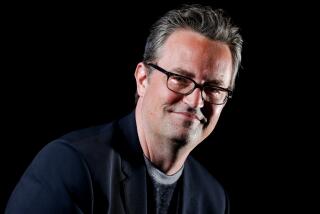Nets’ Richardson Is Latest Casualty in Never-Ending War
- Share via
In the summer of 1980, I set up an interview with Sweet Lou Johnson, a hero of the Dodgers’ World Series championship of 1965. It was to be one of those where-are-they-now stories.
I waited at a coffee shop. Sweet Lou arrived late, in a sports car with the sunroof rolled back.
Later I wrote that Lou looked good. “The walk is springy, the handshake firm and enthusiastic. He leans back in his chair, lights up a big cigar and sweetens his coffee with three packs of sugar.”
I asked Lou if the gold charm he wore on a chain around his neck stood for anything.
“Cocaine,” he told me, matter-of-factly.
I didn’t include that in my story. It didn’t seem important. Cocaine, from what little I knew then, was an innocent party drug.
If I’d asked, I would have learned that Lou, when he was a Series hero in ‘65, was already five baseball seasons into cocaine.
Lou looked good that day we met in ‘80, but he didn’t feel good.
“I was dyin’ inside, man,” he said Wednesday. “I was beggin’ for help.”
Before the year was through, Sweet Lou, a wreck of a man, checked into a drug farm, trying to kick coke and alcohol. He’s been clean ever since.
Today, a lot of us know a lot more about cocaine.
That’s good, because one of the ways a lot of people get sucked into the coke vacuum is through ignorance of the possible consequences.
“I was out with friends at a disco,” said NBA star John Lucas, recalling his first toot. “We snorted a little cocaine. I said, ‘Hey, this is great stuff!’ ”
We’re better informed now, most of us. In sports, attacking the coke problem has become a high priority.
In major league baseball, the problem is all but over, according to Commissioner Peter Ueberroth, who recently promised that his sport would be drug-free this season.
“It’s gone,” Ueberroth said, referring to drugs.
How nice.
Except I’m not so sure it’s that easy.
Even Micheal Ray Richardson’s getting thrown out of the NBA on his nose wasn’t enough to scare everyone straight.
This coke is strong stuff.
“They (hard-core coke users) will lose their family, their job, their money, their friends, their sex life, and still not admit they have a problem,” says Dr. David Lewis, who heads the NBA’s progressive drug program.
Richard Pryor, who turned himself into a human torch while free-basing cocaine, is featured in a film the NBA put together to educate its players.
Says Pryor, “I’d get mad and frustrated. People don’t understand me. The pipe say, (soothing voice) ‘Come on in the room with me, I gotcha covered. I know how you feel, Rich. I understand. Just light me up, hold me for a couple of days and we’ll talk it over.’
“I’m talking a year later, Jack, I’m drawn up, and outta my mind. But I’m not hooked .”
I’m no expert, but it seems to me the two most effective ways of impressing upon people the potential danger of cocaine are: (a) Teaching and informing them, and (b) Letting them set themselves afire.
Method (a) seems preferable. The NBA is the sports leader in this field. This season, Lewis and the NBA sent out four three-person groups to meet with the teams, to talk about drugs, answer questions. These weren’t FBI agents, as the NFL sends out. Just regular people, trained in dealing with drugs and abusers.
NBA players and team personnel are taught to spot a teammate who might have a problem, and steer him to help. Maybe they can ask him about that necklace he’s wearing.
The impact of the NBA’s program will be seen not in the number of players who are kicked out of the league, but in the number who are kicked into the drug rehab program. Or the number who are educated away from starting a habit in the first place.
For too many athletes, like John Lucas, the cocaine education starts with this lecture, delivered by a friend: “Try it, you’ll like it.”
And you will. For a while.
Urine testing is fine, but it is imperfect. There are ways to beat the testing. And even if you throw out all the users, more will be along.
Education is the most realistic form of attack, starting in college. Unfortunately, judging from graduation stats, most athletes in college aren’t even learning the three R’s, let alone the little C. Micheal Ray Richardson, one friend said, left the University of Montana without even having acquired the first R--reading.
The pros are getting better. The Dodgers have baseball’s best drug-education program, headed by Dr. Forrest Tennant.
All the sports will be putting more money and energy into drug education, because they’re afraid of losing fans.
I hope Ueberroth really can wave a magic wand and make drugs disappear. I hope other athletes see Micheal Ray Richardson and throw their free-base pipes out the windows.
But I don’t think it’s going to be that easy. The stuff is too good.
Talking about Richardson, Sweet Lou Johnson says, “People think we’re bullbleepin’ with it (cocaine), that it’s just a game. Here’s a guy who gave up $3 million for coke.”
Micheal Ray is gone and the sports world is just a little bit cleaner today. But, as legendary blues men Sonny Terry and Brownie McGhee sing, “The battle is over, but the war goes on.”
More to Read
Go beyond the scoreboard
Get the latest on L.A.'s teams in the daily Sports Report newsletter.
You may occasionally receive promotional content from the Los Angeles Times.










